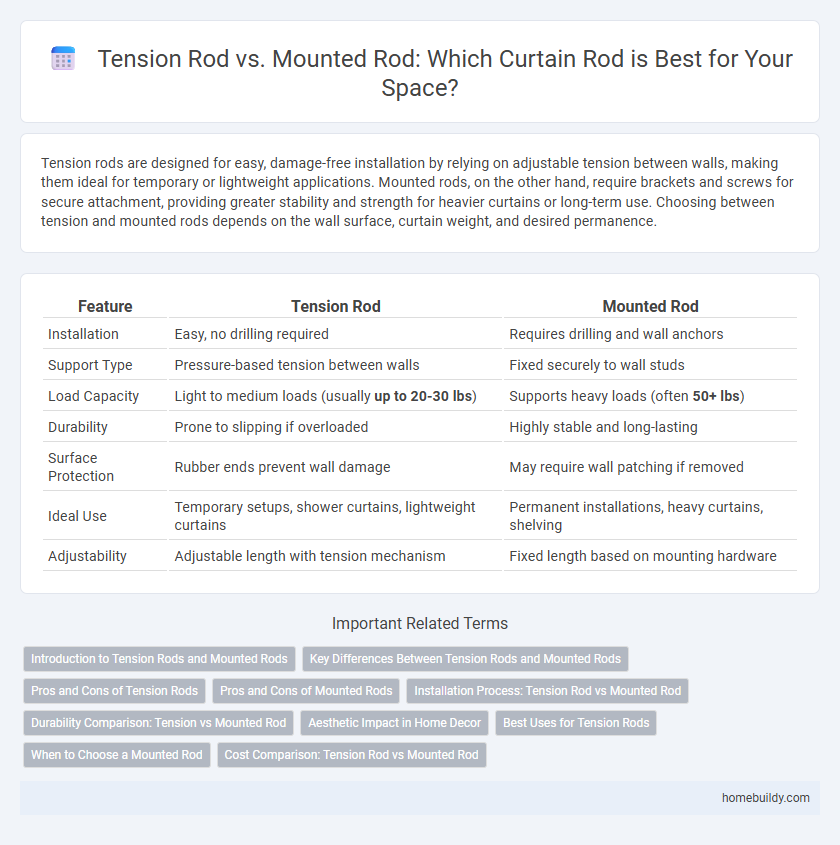Tension rods are designed for easy, damage-free installation by relying on adjustable tension between walls, making them ideal for temporary or lightweight applications. Mounted rods, on the other hand, require brackets and screws for secure attachment, providing greater stability and strength for heavier curtains or long-term use. Choosing between tension and mounted rods depends on the wall surface, curtain weight, and desired permanence.
Table of Comparison
| Feature | Tension Rod | Mounted Rod |
|---|---|---|
| Installation | Easy, no drilling required | Requires drilling and wall anchors |
| Support Type | Pressure-based tension between walls | Fixed securely to wall studs |
| Load Capacity | Light to medium loads (usually up to 20-30 lbs) | Supports heavy loads (often 50+ lbs) |
| Durability | Prone to slipping if overloaded | Highly stable and long-lasting |
| Surface Protection | Rubber ends prevent wall damage | May require wall patching if removed |
| Ideal Use | Temporary setups, shower curtains, lightweight curtains | Permanent installations, heavy curtains, shelving |
| Adjustability | Adjustable length with tension mechanism | Fixed length based on mounting hardware |
Introduction to Tension Rods and Mounted Rods
Tension rods utilize adjustable spring tension to securely fit between two surfaces without the need for hardware, making them ideal for lightweight curtains and temporary setups. Mounted rods rely on brackets screwed into walls or window frames, providing a sturdier and more permanent installation suitable for heavier drapery and high-traffic areas. Both options offer versatile solutions for window treatments, with tension rods emphasizing ease of installation and mounted rods prioritizing durability and support.
Key Differences Between Tension Rods and Mounted Rods
Tension rods rely on adjustable spring-loaded mechanisms to hold firmly between two surfaces without the need for drilling, making installation quick and damage-free. Mounted rods require secure brackets screwed into walls, providing stronger support and better suited for heavier curtains or longer spans. While tension rods offer convenience and portability, mounted rods offer enhanced stability and load capacity ideal for permanent installations.
Pros and Cons of Tension Rods
Tension rods offer easy installation without hardware, making them ideal for temporary or rental spaces where drilling is not permitted. They provide adjustable length and strong grip through spring tension, but may lack stability under heavy loads or frequent use compared to mounted rods secured with brackets. Limited weight capacity and potential slippage are common drawbacks, while their damage-free setup ensures walls remain intact.
Pros and Cons of Mounted Rods
Mounted rods offer a stable and secure installation, ideal for supporting heavy curtains or drapes due to their fixed brackets anchored directly into walls. They provide a cleaner, more permanent look but can be challenging to install, often requiring drilling and wall anchors that may damage surfaces. Unlike tension rods, mounted rods are less flexible for repositioning or temporary setups, making them better suited for long-term curtain solutions.
Installation Process: Tension Rod vs Mounted Rod
Tension rods require no drilling or screws, relying on adjustable spring tension to fit securely between two surfaces, making installation quick and damage-free. Mounted rods necessitate precise measurements and the use of brackets, screws, and anchors to firmly attach the rod to walls or ceilings, which demands tools and can cause permanent modifications. The tension rod's ease of installation suits renters or temporary setups, while mounted rods provide superior stability for heavy-duty applications.
Durability Comparison: Tension vs Mounted Rod
Tension rods rely on spring tension to stay in place without drilling, which can limit their durability under heavy weight or frequent use compared to mounted rods that are securely fixed with brackets. Mounted rods offer superior stability and long-term durability, making them ideal for holding heavier curtains or frequent adjustments. The installation method directly impacts the lifespan, with mounted rods typically enduring more wear and tear.
Aesthetic Impact in Home Decor
Tension rods offer a sleek, minimalistic look by blending seamlessly into window frames without visible brackets, enhancing clean lines and modern aesthetics in home decor. Mounted rods, with their conspicuous hardware and decorative finials, serve as focal points that can complement traditional or ornate design styles. Choosing between tension and mounted rods depends on the desired balance between subtlety and statement-making elements in window treatment design.
Best Uses for Tension Rods
Tension rods excel in temporary or damage-free installations where drilling is not possible, making them ideal for renters or quick fixes in kitchens and bathrooms. Their adjustable length and spring-loaded mechanism allow for easy setup in varying window frames or small spaces without the need for hardware. Tension rods are best suited for lightweight curtains, shower curtains, and closet organization applications where portability and minimal wall impact are priorities.
When to Choose a Mounted Rod
Mounted rods provide superior stability for heavy curtains or broader window spans, making them ideal for rooms requiring robust hardware. Choose a mounted rod when permanent installation is preferred, ensuring durability and resistance to movement over time. This option supports larger drapery weight and offers a clean, streamlined appearance in professional or high-traffic areas.
Cost Comparison: Tension Rod vs Mounted Rod
Tension rods typically offer a lower upfront cost due to easier installation and lack of hardware requirements, making them a budget-friendly choice for renters or temporary setups. Mounted rods require drilling and brackets, increasing material and labor expenses, but provide greater durability and stability for long-term use. Evaluating the total cost involves balancing initial savings of tension rods against the investment in the sturdier, permanent solution of mounted rods.
Tension rod vs Mounted rod Infographic

 homebuildy.com
homebuildy.com